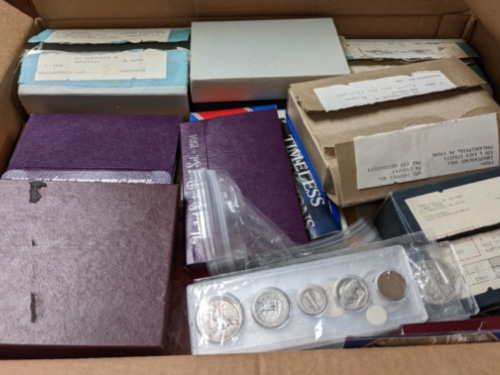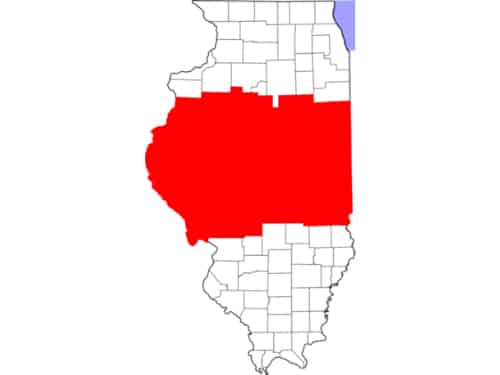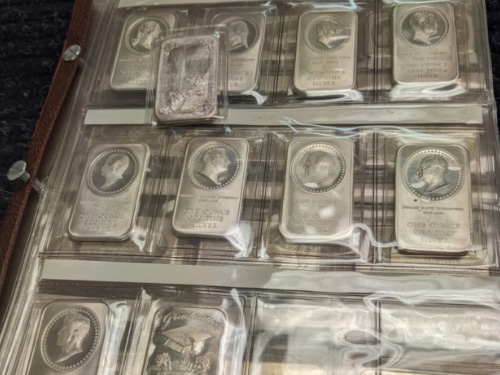Oakton Coins & Collectibles is one of the highest-rated coin shops in all of Illinois.
If you are considering selling your coin collection, you’ve come to the right place.
Oakton Coins and Collectibles understands that selling a single coin or a whole coin collection can be an extremely daunting task. Whether you’re a lifetime coin collector or have recently inherited a coin collection, when it comes time to sell your coins you have many options, and Oakton Coins & Collectibles can simplify the process. Although we’re located in Northern Illinois, many people from Central Illinois mail us their collections as well. Usually, we communicate via email or texting regarding the appraisal. We always reimburse shipping costs and send you a check very quickly. Many people in Central Illinois trust us with their valuables because of our track record of discretion and consistently high payments.
Understanding How to Sell Coins around Central Illinois
When it comes to selling coins, you need to take a lot of factors into account. For instance, your coins could simply be worth face value, or they could be worth a significant amount of money. People don’t only collect valuable coins; often, they collect low-value or face-value coins for other reasons. But no matter the size or value of your collection, we’re here to help.
Sometimes, people sell their whole collection. Other times, they sell the valuable parts and split up the rest between relatives.
Often, people send us their coins carefully arranged by date and decade and placed in separate Ziploc bags or paper envelopes/coin tubes. You might be tempted to do this, but it’s not worth the effort.
When we appraise a collection, the first thing we do is separate coins by their composition (e.g., copper, nickel, silver, or gold). If you feel you must organize your collection, please put it into these groups:
- Gold coins
- 9o% silver dollars (1878 through 1935)
- 9o% silver dimes, quarters, and half dollars (1892 through 1964)
- 40% silver JFK half dollars (1965 through 1970)
- Lincoln wheat cents (1909 through 1958)
- Buffalo nickels (1913 through 1938)
- Jefferson nickels (1938 and later)
- All other obsolete U.S. coins
- U.S. mint proof and uncirculated sets
- U.S. mint commemorative sets
- Currency and paper money
- Foreign coins/tokens
Interesting coins are available for purchase in every budget range, so ask yourself the following questions to help determine your collection’s value:
- Can you determine how much money the collector spent or how regularly the owner bought?
- Can you find any bills of sale, invoices, or canceled checks from dealers or auction firms?
- Do you have an insurance policy or a will with instructions?
This information may be helpful, but you can’t completely depend on any of it. The value of coins (and collectible paper money), like the value of anything else, is what a willing buyer will pay a willing seller. This amount is never a fixed figure, as the market fluctuates in varying degrees and at unpredictable rates.
Pricing Your Collection to Sell around Central Illinois
Ninety-nine percent of the time, you won’t receive the value listed in any of the pricing guides that you may reference when you sell coins. The guides are simply a way to help you establish the price range you can reasonably expect for a coin. Most consumer guides show extremely inflated values.
Keep these coin-selling terms in mind: clickbait pricing, real-world pricing, melt-value pricing, and numismatics pricing.
Clickbait Pricing: Wikipedia defines “clickbait” as web content that is aimed at generating online advertising revenue, especially at the expense of quality or accuracy. This pricing relies on sensationalist headlines to attract click-throughs. Click-throughs refer to when the reader clicks a link to go through to the next stage of the bait. Clickbait creators love to post about how common coins could be worth big money, but in reality their claims are almost never valid.
Real-World Pricing: Real-world pricing refers to actual money changing hands. This pricing reflects amounts that have actually been paid, not just advertised, so it’s true market value. Everything else is just a bunch of words and ideas about value. Any coin is only worth what someone will pay for it, and collectors usually focus on rarity and condition to determine monetary value.
Melt-Value Pricing: Prior to 1965, the majority of United States coins contained either gold or silver (with a few exceptions). Any selling premium on top of the melt value comes from the numismatic value.
Numismatics: Numismatics is the study of coins, paper currency, and metals. Coin rarity and condition drive the prices that collectors will pay. Regardless of their metal composition, some coins have a very high numismatic value.
Places NOT to Sell Coins around Central Illinois
- Jewelry Stores and Pawn Shops – These places usually only understand the precious metal part of gold/silver coins, and they pay only a small percentage of that price.
- eBay – Many coins are sold on eBay every day, but doing so can be very risky, time consuming, and costly. Click here for more information.
Sell Coins near Me – Central Illinois
Oakton Coins is conveniently located right near 94 West (Kennedy) near downtown Skokie (very close to Chicago), and less than two blocks from the Oakton stop on the Yellow Line CTA (Skokie Swift). Peoria, Springfield, Decatur, Quincy, Champaign–Urbana, Bloomington-Normal, Galesburg, & Danville.
Glossary of numismatic terms, D;
D – A mintmark used to indicate coins struck at the Dahlonega, Georgia branch mint from 1838-1861 or the Denver, Colorado branch mint from 1906 to the present.
Dahlonega Mint – A branch of the United States Mint, located in Dahlonega, Georgia, that produced gold coins from 1838-1861 and was closed due to the Civil War. This mint uses the “D” mintmark.
Damaged Coin – A coin that has been impaired apart from normal wear, by scraping, drilling, polishing, or other abuse. Generally, a damaged coin will not be given a stand-alone grading designation but will be described adjectivally. Example: 1822 cent, holed at the top, otherwise VF-30. Such a coin must not be simply described as VF-30 without further comment.
Date – The numerals on a coin that represent the year the coin was struck . Restrikes are made in years subsequent to the date that appears on them.
Date Size Descriptions – Terms are used to differentiate the size of the numerals on the date of a given coin, comparative in relation to other varieties of the same issue. Such terms as Small Date, Large Date, and Medium Date are often used. Often capitalized in numismatic usage.
Date Spacing (Width) Descriptions – Terms such as Wide Date, Compact Date, Narrow Date, etc., are sometimes employed to describe the spacing of numerals within a date or the overall width of a date, comparative in relation to other varieties of the same issue.
DCAM – An abbreviation for Deep Cameo contrast.
DDO – An abbreviation for doubled die obverse.
Dealer – One who buys, sells, and trades numismatic material.
Deep Cameo – A term that applies typically to a Proof or prooflike coin with deeply frosted central devices and lettering in high contrast to the mirror like fields. Sometimes these are called “black and white” cameos.
Deep Cameo Contrast – Describes the portrait or devices on a Proof coin being especially frosted or satiny, or cameo, in contrast with mirrorlike fields. Abbreviated DCAM. Seemingly more contrasted than Cameo (CAM). Certain of this is semantics, with actual differences being slight between various cameo designations.
Deep Mirror Prooflike – An Uncirculated coin with the fields struck from highly polished or mirrored dies, and closely resembling a Proof.
Demand Note – Notes issued in 1861 and early 1862 redeemable in gold coins, with denominations $5 to $20.
Denomination – The value assigned to a specific coin or piece of currency by the government.
Denticles – Small, toothlike projections around the inner rim of some coins, most often seen on coins from the 18th and 19th centuries.
Dentils – A shortened term for denticles.
Denver Mint – A branch of the United States Mint, located in Denver, Colorado that manufactures coins of all denominations for general circulation, stores gold and silver bullion, medals, coin dies, and manufactures Uncirculated coin sets and commemorative coins. The Denver Mint was established in 1906 and uses the “D” mintmark.
Design – A coin or other numismatic item’s motif. Peace dollars, Buffalo nickels, and Liberty double eagles are examples of designs.
Design Type – A distinct motif that is on a coin or other numismatic item and used for multiple denominations or subtypes. An example would be the Barber design type that was used on silver dimes, quarters and half dollars.
Designation – A characteristic added to a coin’s grade that specifies a certain attribute or quality such as color, strike or appearance not covered by the numerical grade. Not all series and denominations have designations, but for those that do, the associated designation will affect the coin’s value. Copper coins have color designations of Red, Red-Brown, and Brown. Standing Liberty quarters can have the designation of Full Head, where Miss Liberty’s head is fully struck. Some other designations include: Prooflike, Deep Cameo, Deep Mirror Prooflike.
Designer – The artist who creates a coin’s design.



